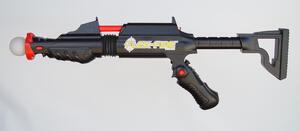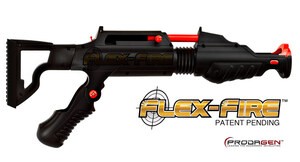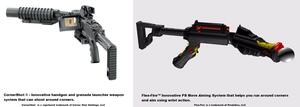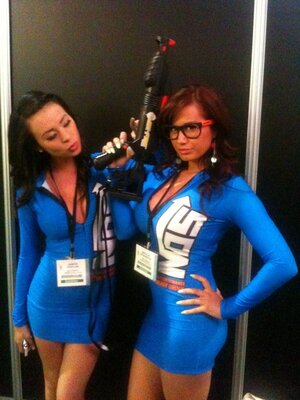
We’ve been dominating the online leaderboards with Flex-Fire’s unique flexible barrel system for months now and given our own impression in our First Impressions: Flex-Fire article. But we’ve hunted down Flex-Fire’s inventor Adam Wickam and shot a few questions of our own at him to find out a bit more about this unique PlayStation Move peripheral.
Movemodo: Firstly, can you please introduce yourself for our readers?
Adam Wickam: I am Adam Wickam, a 30 year old PS3 gamer, fisherman, and father of one.
MM: What caused your decision to try your hand at creating a ‘better’ gun peripheral?
Adam Wickam: Motion control shooter games have a ton of potential, but controlling the field of view is notoriously difficult. I knew there had to be a better way.
MM: Was the flexible barrel part of your first design or did that come later? If so, how did this design come about?
Adam Wickam: On my first attempt to make my own gun peripheral, the plumbing parts I used had flex and proved to make playing the games easier. From there I tried several types of flex joints and materials. Other prototypes included parts of other gun peripherals, vacuums, doors, paintball guns, airsoft guns, flashlights, bondo, glue and paint.

MM: In your opinion, what elements does the flexible barrel bring to the table that other gun peripherals lack?
Adam Wickam: It is amazing how many problems that the flex barrel actually addresses:
Play from any position
Because other attachments are aimed using back and arm movements, gamers must stand up or sit on the edge of their chair to have full range of motion. This is tiring and your back is not really made for precise movements. The flex lets you control the movement with your wrist, so you can have your elbows and back fixed. I actually prefer to play in a recliner with both my arms posted. This gives me the best control and I can play for hours without tiring.
One to one movement
The length of other attachments actually works against you. Small movements are actually amplified because of the length between the stock butt and the sensor. Because of its length, the Sharp Shooter actually makes the Move three times more sensitive when the stock is fully extended. Flex-Fire lets you keep the one to one movement.

Center point of reference
When you look at the DualShock 3, the thumbstick always wants to be centered, i.e. when you release pressure on the stick it re-centers. This is exactly what the Flex-Fire does. This has multiple benefits; the most remarkable is that a player can move the signal into the deadzone by bending the barrel, then by releasing the pressure, the Flex-Fire recenters and the cursor stops. This reduces the over correction that I’m sure you all are aware of. Instead of trying to figure out where to stop the crosshairs when you’re running around, you just point the gun at the center of the screen and whenever you want to stop the cursor, you just relax and it will stop your movement. Also because the Flex-Fire always wants to re-center, you can make micro adjustments to the Move controller signal.
Make up for calibration issues
Anyone who has used the Move seriously is aware that calibration can get out of whack from time to time. The Flex-Fire lets you make up for mis-calibration by bending the flex. That lets you finish the level or wait until you get to a safe place to recalibrate.
MM: Once you decided on a final design, what challenges did you have to overcome to make Flex-Fire become a reality?
Adam Wickam: Having a 3D model of the product is a feat in itself, but there have been many challenges between then and today. The 3D model was used to make an injection mould tool set. From there we made the first injection moulded Flex-Fires. These were the units I brought to E3 2010. From there we went through many rounds of tooling changes to make the Flex-Fire’s mechanically tight and robust. We also added textures, which is the final step.

I would just like to say the Flex-Fire is a controller system, and although it looks like a gun, it is first a tool and second a gun attachment.
Marketing to a generation that doesn’t necessarily want to accept motion controls is a challenge. Also we are competing with Sony directly as they have the Sharp Shooter. Gamers are attracted to the buttons on the Sharp Shooter. If you look at the real reason the SS has the mapped buttons, it’s because they have the Nav controller up front. Without the mapped buttons, the buttons on the Motion controller can’t be accessed. For me the SS doesn’t feel like a gun once the Nav is incorporated. Flex-Fire doesn’t have that issue because the Nav is in the pistol grip. All the buttons are easily accessed on the Flex-Fire.
Another challenge is that Sony/developers have not included custom button mapping on the Move games, which leads to the shoot button being on the Motion controller. For me I would rather be better at the game and have the shoot button up front, than have a trigger and get my butt handed to me online. It is usually the same people who say guns don’t bend. I would just like to say the Flex-Fire is a controller system, and although it looks like a gun, it is first a tool and second a gun attachment.
MM: Would any of this have been possible without PlayStation Move?
Adam Wickam: I am glad to be part of the PS3 product generation, the games being produced for the Move have been awesome lately. The flex technology works great with the Wii and may work with the Wii U. Nintendo says they will have a more hardcore game line up for Wii U, but we’ll see. The flex technology really works, so who knows, maybe laser weapons of the future will have flex joints. No force recoil?
MM: We have to ask, what is the game that you think shows off Flex-Fire’s unique capabilities the best?
Adam Wickam: My favorite Move game is Killzone 3. It’s great for hip shooting, which I think shows off the Flex-Fire’s skills well. Also on KZ3, with the Infiltrator and a perk, you have full endurance so you can continually run. Because of the Flex-Tech, you can corner very fast and maintain control while running around and meleeing people on multiplayer. Flex-Fire is also great for sniping. Really, the Flex helps on all the shooter games I’ve played with the Move.
MM: Lastly, is there anything else you’d like to tell our readers about Flex-Fire?
Adam Wickam: The Move offers advantages over the DualShock. The fast twitch controls combined with the deadzones make the Move faster and more efficient. Flex-Fire makes controlling the Move easier and makes you faster and more accurate, while reducing over correction. The Flex is the missing link of motion control. Flex-Fire has the answer to the wonky aim/look that you have all experienced and it lets you play from any position. Small changes make big differences on the battlefield. The difference between a .75 K/D and a 1+ K/D is being a little faster, a little more accurate and more controlled than the guy shooting at you.
Thanks to Adam Wickam for his time.
Comments 0
Wow, no comments yet... why not be the first?
Leave A Comment
Hold on there, you need to login to post a comment...